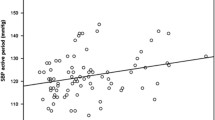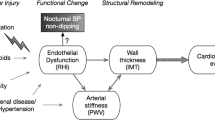Abstract
Objective
The lack of nocturnal decline in blood pressure (BP) is associated with an increase in cardiovascular events. Soluble CD40 ligand (sCD40L) is involved in the pathogenesis of risk factor-related vascular damage. The purpose of this study was to examine the relationship between vascular endothelial functions, carotid intima-media thickness (cIMT), plasma sCD40L levels and circadian BP profile in patients with essential hypertension.
Material and methods
The study population consisted of 81 essential hypertensive out-patients. BP dipping was defined as a night-to-day systolic and diastolic decrease ≥10%. Forty-seven dipper and 34 nondipper patients were compared. High sensitivity C-reactive protein (hs-CRP), sCD40L and urinary albumin were measured. Brachial artery flow-mediated dilatation (FMD) and cIMT was compared between the groups.
Results
sCD40L level (3.28 ± 2.08 and 2.30 ± 1.99 ng/ml, respectively, P = 0.036) and urinary albumin concentration (36.7 ± 20.1 and 23 ± 29.7 mg/l, respectively, P < 0.0001) were higher in nondippers than in dippers. Serum hs-CRP levels were not significantly different. FMD was found higher in dippers than nondippers (11.8 ± 3.9% and 6.6 ± 2.2%, respectively, P < 0.0001). The average cIMT was significantly higher in nondippers than dippers (0.928 ± 0.060 Vs. 0.734 ± 0.134 mm; P < 0.0001).
Conclusions
Nondipper patern has an additional negative effect on endothelial functions in hypertensive patients. Nondippers have enhanced sCD40L levels, which may contribute to their increased susceptibility to develop vascular damage.
Similar content being viewed by others
References
Ahn ER, Lander G, Jy W, Bidot CJ, Jimenez JJ, Horstman LL, Ahn YS (2004) Differences of soluble CD40L in sera and plasma: implications on CD40L assay as a marker of thrombotic risk. Thromb Res 114:143–148
Andrè P, Nannizzi-Alaimo L, Prasad AK, Phillips DR (2002) Plateletderived CD40L. The switch-hitting player of cardiovascular disease. Circulation 106:896–899
Becker BF, Heindl B, Kupatt C, Zahler S (2000) Endothelial function and hemostasis. Z Kardiol 89:160–167
Becker BF, Heindl B, Kupatt C, Zahler S (2000) Endothelial function and hemostasis. Z Kardiol 89(3):160–167
Blann AD, Nadar S, Lip GYH (2003) Pharmacological modulations of platelet function in hypertension. Hypertension 42:1–7
Corretti MC, Anderson TJ, Benjamin EJ et al (2002) Guidelines for the ultrasound assessment of endothelial-dependent flow-mediated vasodilation of the brachial artery. J Am Coll Cardiol 39:257–265
Cuspidi C, Macca G, Sampieri L, Fusi V, Severgnini B, Michey I, Salerno M, Magrini F, Zanchetti A (2001) Target organ damage and non-dipping pattern defined by two sessions of ambulatory blood pressure monitoring in recently diagnosed hypertensive patients. J Hypertens 19:1539–1545
Desideri G, Cipollone F, Valeri L, Grassi D, Necozione S, Croce G, Passacquale G, Garofalo A, Lippi C, Mezzetti A, Ferri C (2007) Enhanced plasma soluble CD40 ligand levels in essential hypertensive patients with blunted nocturnal blood pressure decrease. Am J Hypertens 20:70–76
Devereux RB, Alonso DR, Lutas EM et al (1986) Echocardiographic assessment of left ventricular hypertrophy: comparison to necropsy findings. Am J Cardiol 57:450–458
Duygu H (2007) Endothelial functions and hypertension. J Card Res 5:73–81
Furumoto T, Saito N, Dong J, Mikami T, Fujii S, Kitabatake A (2002) Association of cardiovascular risk factors and endothelial dysfunction in Japanese hypertensive patients: implications for early atherosclerosis. Hypertens Res 25:475–480
Gimbrone MA Jr (1995) Vascular endothelium in health and disease. In: Haber E (ed) Molecular cardiovascular medicine, chap 4. Scientific American Medicine, New York, pp 49–61
Henn V, Slupsky JR, Grafe M (1998) CD40 ligand on activated platelets triggers an inflammatory reaction of endothelial cells. Nature 391:591–594
Higashi Y, Nakagawa K, Kimura M, Noma K, Hara K, Sasaki S, Goto C, Oshima T, Chayama K, Yoshizumi M (2002) Circadian variation of blood pressure and endothelial function in patients with essential hypertension:a comparison of dippers and non-dippers. J Am Coll Cardiol 40:2039–2043
Karmann K, Hughes CC, Schechner J, Fanslow WC, Pober JS (1995) CD40 on human endothelial cells: inducibility by cytokines and functional regulation of adhesion molecule expression. Proc Natl Acad Sci USA 92:4342–4346
von Känel R, Jain S, Mills PJ, Nelesen RA, Adler KA, Hong S, Perez CJ, Dimsdale JE (2004) Relation of nocturnal blood pressure dipping to cellular adhesion, inflammation and hemostasis. J Hypertens 22:2087–2093
Lee KW, Blann AD, Lip GY (2005) High pulse pressure and nondipping circadian blood pressure in patients with coronary artery disease: relationship to thrombogenesis and endothelial damage/dysfunction. Am J Hypertens 18:104–115
Lee IK, Kim HS, Bae JH (2002) Endothelial dysfunction: its relationship with acute hyperglycaemia and hyperlipidemia. Int J Clin Pract Suppl 129:59–64
Mach F, Schonbeck U, Bonnefoy JY, Pober JS, Libby P (1997) Activation of monocyte/macrophage functions related to acute atheroma complication by ligation of CD40: induction of collagenase, stromelysin, and tissue factor. Circulation 96:396–399
Minuz P, Patrignani P, Gaino S, Seta F, Capone ML, Tacconelli S, Degan M, Faccini G, Fornasiero A, Talamini G, Tommasoli R, Arosio E, Santonastaso CL, Lechi A, Patrono C (2004) Determinants of platelet activation in human essential hypertension. Hypertension 43:64–70
Ohkubo T, Hozawa A, Yamaguchi J et al (2002) Prognostic significance of the nocturnal decline in blood pressure in individuals with and without high 24-h high blood pressure: the Ohasama Study. J Hypertens 20:2183–2189
Patel JV, Lim HS, Nadar S, Tayebjee M, Hughes EA, Lip GY (2006) Abnormal soluble CD40 ligand and C-reactive protein concentrations in hypertension: relationship to indices of angiogenesis. J Hypertens 24:117–121
Pierdomenico S, Lapenna D, Guglielmi MD, Costantini F, Romano F, Schiavone C, Cuccurullo F, Mezzetti A (1997) Arterial disease in dipper and non-dipper hypertensive patients. Am J Hypertens 10:511–518
Rizzo V, Maio FD, Campbell SV et al (2000) Left ventricular function, cardiac dysrhythmias, atrial activation, and volumes in nondipper hypertensive individuals with left ventricular hypertrophy. Am Heart J 139:529–536
Sahn DJ, DeMaria A, Kisslo J, Weyman A (1978) The Committee on M-mode standardization of the American Society of Echocardiography: recommendations regarding quantitation in M-mode echocardiography: results of a survey of echocardiographic measurements. Circulation 58:1072–1083
Saka B, Oflaz H, Erten N, Bahat G, Dursun M, Pamukcu B, Mercanoglu F, Meric M, Karan MA (2005) Non-invasive evaluation of endothelial function in hypertensive elderly patients. Arch Gerontol Geriatr 40(1):61–71
Schonbeck U, Libby P (2001) CD40 signaling and plaque instability. Circ Res 89:1092–1103
Schonbeck U, Libby P (2001) The CD40/CD154 receptor/ligand dyad. Cell Mol Life Sci 58:4–43
Schonbeck U, Mach F, Bonnefoy JY, Loppnow H, Flad HD, Libby P (1997) Ligation of CD40 activates interleukin 1beta-converting enzyme (caspase-1) activity in vascular smooth muscle and endothelial cells and promotes elaboration of active interleukin 1beta. J Biol Chem 272:19569–19574
Schonbeck U, Mach F, Sukhova GK, Herman M, Graber P, Kehry MR, Libby P (2000) CD40 ligation induces tissue factor expression in human vascular smooth muscle cells. Am J Pathol 156:7–14
Schonbeck U, Mach F, Sukhova GK, Murphy C, Bonnefoy JY, Fabunmi RP, Libby P (1997) Regulation of matrix metalloproteinase expression in human vascular smooth muscle cells by T lymphocytes: a role for CD40 signaling in plaque rupture? Circ Res 81:448–454
Staessen JA, Thijs L, Fagard R et al (1999) Predicting cardiovascular risk using conventional vs ambulatory blood pressure in older patients with systolic hypertension. JAMA 282:539–546
Suzuki Y, Kuwajima I, Aono T et al (2000) Prognostic value of nighttime blood pressure in the elderly: a prospective study of 24-hour blood pressure. Hypertens Res 23:323–330
Toledo JC, Tacito LH, Melo SE, Sousa W, Colombo F, Irigoyen MC, Franchini K, Coelho OR, Moreno H (2005) Low-renin (volume dependent) mild-hypertensive patients have impaired flow-mediated and glyceryl-trinitrate stimulated vascular reactivity. Circ J 69(11):1380–1385
Verdecchia P, Borgioni C, Ciucci A et al (1996) Prognostic significance of blood pressure variability in essential hypertension. Blood Press Monit 1:3–11
Verdecchia P, Porcellati C, Schillaci G, Borgioni C, Ciucci A, Battistelli M, Guerrieri M, Gatteschi C, Zampi I, Santucci A, Santucci C, Reboldi G (1994) Ambulatory blood pressure: an independent predictor of prognosis in essential hypertension. Hypertension 24:793–801
Verdecchia P, Schillaci G, Gatteschi C, Zampi I, Battistelli M, Bartoccini C, Porcellati C (1993) Blunted nocturnal fall in blood pressure in hypertensive women with future cardiovascular morbid events. Circulation 88:986–992
Vishnevetsky D, Kiyanista VA, Gandhi PJ (2004) CD40 ligand: a novel target in the fight against cardiovascular disease. Ann Pharmacother 38:1500–1508
Yan JC, Ma GS, Wu ZG, Kong XT, Zong RQ, Zhan LZ (2005) Increased levels of CD40-CD40 ligand system in patients with essential hypertension. Clin Chim Acta 355:191–196
Author information
Authors and Affiliations
Corresponding author
Rights and permissions
About this article
Cite this article
Alioglu, E., Turk, U.O., Bicak, F. et al. Vascular endothelial functions, carotid intima-media thickness, and soluble CD40 ligand levels in dipper and nondipper essential hypertensive patients. Clin Res Cardiol 97, 457–462 (2008). https://doi.org/10.1007/s00392-008-0654-9
Received:
Accepted:
Published:
Issue Date:
DOI: https://doi.org/10.1007/s00392-008-0654-9




